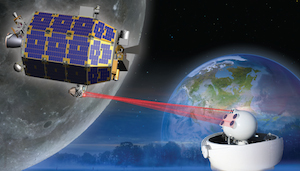LADEE
The Lunar Laser Communications Demonstration (LLCD) was part of the Lunar Atmosphere and Dust Environment Explorer (LADEE) mission in 2013, a collaboration between NASA and MIT Lincoln Laboratory. The satellite successfully established an optical link and was able to transmit data at a rate of 622 Mbps, with an upload speed of 20 Mbps from the ground station in White Sands, New Mexico. This groundbreaking mission demonstrates the capabilities of optical communication as a means of data transmission from space, but differs from the SSI's OpComms project in several considerable respects. Most importantly, the LADEE orbiter had a dry mass of approximately 250kg, substantially larger than the CubeSat the OpComms team aims to develop. In addition, the LLCD was not able to maintain continuous communication for long periods of time, due to power constraints, while the SSI team hopes to achieve near continuous uptime with lower power optical systems. Still, the LLCD/LADEE mission establishes an encouraging precedent for the feasibility of free-space optical communications from space.
More information can be found on the NASA Goddard website [1].
